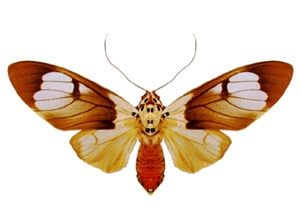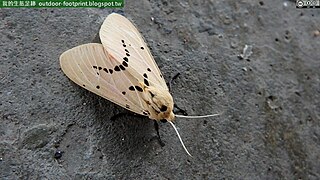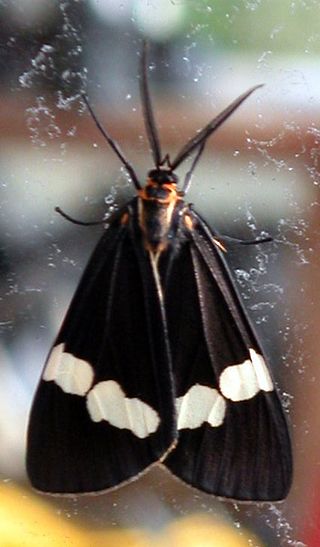
The Arctiinae are a large and diverse subfamily of moths with around 11,000 species found all over the world, including 6,000 neotropical species. This subfamily includes the groups commonly known as tiger moths, which usually have bright colours, footmen, which are usually much drabber, lichen moths, and wasp moths. Many species have "hairy" caterpillars that are popularly known as woolly bears or woolly worms. The scientific name Arctiinae refers to this hairiness. Some species within the Arctiinae have the word "tussock"' in their common names because they have been misidentified as members of the Lymantriinae subfamily based on the characteristics of the larvae.

Nyctemera is a genus of tiger moths in the family Erebidae first described by Jacob Hübner in 1820. The genus includes the species Nyctemera annulata and Nyctemera amica, which are closely related and are able to interbreed.

The Arctiini are a tribe of tiger moths in the family Erebidae.

Amerila is a genus of moths in the subfamily Arctiinae.
Calpenia is a genus of tiger moths in the family Erebidae. The genus was erected by Frederic Moore in 1872.

Eyralpenus is a genus of tiger moths in the family Erebidae. The genus was erected by Arthur Gardiner Butler in 1875. The moths in the genus are found in the Afrotropics.

Nebrarctia is a genus of moths in the family Erebidae from the Near East, Central Asia and Himalayas. The genus was erected by Otto Staudinger in 1891.
Paraspilarctia is a genus of moths in the family Erebidae. It occurs in China, Taiwan, and northern Vietnam.

Spilarctia is a genus of moths in the family Erebidae. The genus was erected by Arthur Gardiner Butler in 1875.
Ebertarctia is a genus of tiger moths in the family Erebidae. The moths occur in Iran and Afghanistan.

The Nyctemerina are a subtribe of woolly bear moths in the family Erebidae.
Juxtarctia is a genus of tiger moths in the family Erebidae. The genus is contains only two species, with Juxtarctia multiguttata being described by Francis Walker in 1855, which is endemic for the Himalayas, and Juxtarctia lizae from Laos.

Juxtarctia multiguttata is a polymorphic tiger-moth in the subfamily Arctiinae, endemic for Himalayas. It is known from India: north-west Himalayas, Sikkim, Assam; Nepal; Bhutan; Myanmar; China: Tibet within western slopes of the Himalayas; Indochina.

Mangina is a genus of tiger moths in the family Erebidae.
Amerila eugenia is a moth of the subfamily Arctiinae. It was described by Johan Christian Fabricius in 1794. It is found in China, Pakistan (Karachi), central and southern India and Sri-Lanka.
Amerila lactea is a moth of the subfamily Arctiinae. It was described by Walter Rothschild in 1910. It is found in Myanmar and Nepal.
Amerila rhodopa is a moth of the subfamily Arctiinae. It was described by Francis Walker in 1865. It is found in India.
Argyarctia fuscobasalis is a moth of the family Erebidae. It was described by Shōnen Matsumura in 1930. It is found in Taiwan.
Argyarctia reikoae is a moth of the family Erebidae. It was described by Yasunori Kishida in 1984. It is found in Taiwan.
Argyarctia sericeipennis is a moth of the family Erebidae. It was described by Rothschild in 1933. It is found in China (Yunnan).










